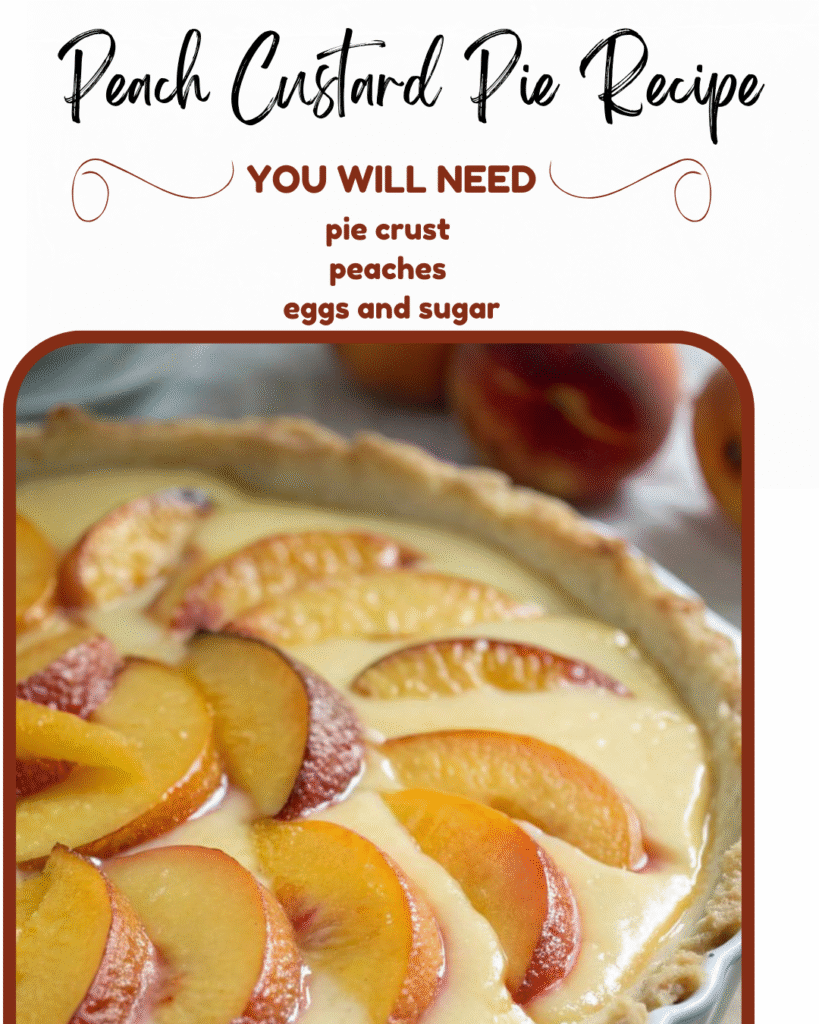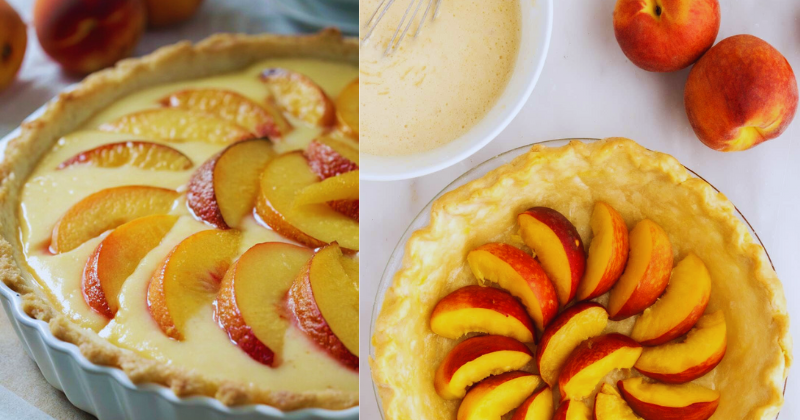Tired of soggy-bottomed fruit pies and grainy custard fillings that never quite set properly? This peach custard pie solves both problems with a foolproof technique that creates a crisp, golden crust and velvety smooth custard that highlights the natural sweetness of ripe peaches. Unlike traditional peach pies that can become watery messes, this recipe combines the best of both worlds – fresh fruit and luxurious custard – in one show-stopping dessert that’s surprisingly simple to master. You’ll get restaurant-quality results every time, with a filling that stays perfectly set when sliced and a crust that maintains its crunch even hours after baking.
Table of Contents
Why This Peach Custard Pie Recipe Works
This peach custard pie recipe eliminates the guesswork that plagues most custard-based desserts. The secret lies in the controlled cooking method that prevents curdling while ensuring proper thickening. By partially cooking the custard base on the stovetop before adding it to the pie shell, we create a stable foundation that won’t separate during baking.
Traditional custard pies often suffer from temperature shock – going directly from cold filling to hot oven causes uneven cooking and texture issues. This streamlined approach uses a two-stage cooking process that guarantees smooth, silky results. The peaches are lightly macerated to draw out excess moisture, preventing the dreaded soggy bottom crust that ruins so many fruit pies.
Professional bakeries use similar techniques to ensure consistent results, and now you can achieve the same reliability at home. The custard base incorporates both eggs and a small amount of cornstarch for stability, while vanilla and a hint of nutmeg complement the peach flavor without overwhelming it.
Essential Equipment and Ingredients
Key Equipment
- 9-inch pie pan (preferably ceramic or glass) – Even heat distribution prevents hot spots that can curdle custard
- Heavy-bottomed saucepan – Essential for gentle, controlled heating of the custard base
- Fine-mesh strainer – Ensures perfectly smooth custard by catching any cooked egg bits
- Sharp paring knife – Clean, precise cuts when peeling and slicing peaches
- Wire cooling rack – Proper air circulation prevents condensation under the pie
- Instant-read thermometer – Takes guesswork out of custard temperature
Ingredient Selection Tips
- Fresh peaches: Look for fruit that yields slightly to pressure with a sweet aroma at the stem end. Avoid rock-hard or overly soft specimens. If peaches aren’t perfectly ripe, let them sit at room temperature for 2-3 days.
- Heavy cream: Full-fat cream (36% butterfat) creates the richest custard. Half-and-half can be substituted but reduces richness.
- Farm-fresh eggs: High-quality eggs with bright orange yolks produce better color and flavor. Room temperature eggs incorporate more easily.
- Pure vanilla extract: Skip imitation vanilla – real extract makes a noticeable difference in custard desserts.
- Unsalted butter: Allows better control over salt content and prevents over-browning of the crust edges.

Step-by-Step Cooking Instructions
Preparation (Prep Time: 25 minutes)
- Prepare the pie crust: Roll out pastry dough and fit into a 9-inch pie pan. Trim edges, crimp decoratively, and refrigerate for 30 minutes. This prevents shrinkage during blind baking.
- Blind bake the crust: Preheat oven to 425°F. Line crust with parchment paper, fill with pie weights or dried beans, and bake 12 minutes. Remove weights and parchment, bake additional 5 minutes until lightly golden. Cool completely.
- Prepare peaches: Bring a pot of water to boil. Score an « X » on the bottom of each peach, blanch for 30 seconds, then transfer to ice water. Skins will slip off easily. Slice into ¼-inch wedges, discarding pits.
- Macerate peaches: Toss sliced peaches with 2 tablespoons sugar and let sit 15 minutes. This draws out excess moisture that could make the crust soggy.
Cooking Method (Cook Time: 45 minutes)
- Make custard base: In heavy saucepan, whisk together 3 large eggs, ½ cup sugar, 2 tablespoons cornstarch, and ¼ teaspoon salt until smooth. Gradually whisk in 1½ cups heavy cream and 1 teaspoon vanilla extract.
- Cook custard: Place saucepan over medium-low heat, whisking constantly. Cook 5-7 minutes until mixture coats the back of a spoon and reaches 170°F on instant-read thermometer. Don’t let it boil or eggs will scramble.
- Strain custard: Immediately pour through fine-mesh strainer into clean bowl to remove any lumps. Whisk in 2 tablespoons butter and ¼ teaspoon fresh grated nutmeg.
- Assemble pie: Drain macerated peaches and arrange in pre-baked pie shell in overlapping concentric circles. Pour warm custard over peaches, ensuring even distribution.
- Bake pie: Reduce oven temperature to 325°F. Bake 35-40 minutes until center is just set but still has slight jiggle when gently shaken. Edges should be lightly golden.
- Cool properly: Cool on wire rack for 2 hours at room temperature, then refrigerate at least 3 hours before serving. This allows custard to fully set.
Pro Tips for Perfect Results
Temperature control is everything – Use an instant-read thermometer when making custard base. Overheating causes curdling that can’t be fixed, while underheating results in thin, runny filling that won’t set properly during baking.
Prevent overbaking by watching for visual cues rather than relying solely on time. The center should have a slight jiggle when gently shaken – it will continue cooking from residual heat as it cools.
Combat soggy crust by macerating peaches beforehand and draining thoroughly. The brief sugar treatment draws out moisture that would otherwise seep into the crust during baking.
Strain everything – Even experienced bakers occasionally get small lumps in custard. Straining ensures silky smooth texture and professional presentation every time.
Plan ahead for success – This pie actually tastes better the day after baking, as flavors meld and custard firms up perfectly. Make it a day ahead for stress-free entertaining.
Serving Suggestions and Variations
How to Serve
Present this elegant dessert at room temperature or slightly chilled, cut into generous wedges with a sharp, clean knife dipped in warm water between cuts. The creamy custard pairs beautifully with a dollop of lightly sweetened whipped cream or a scoop of vanilla bean ice cream. For special occasions, garnish with fresh mint leaves or a light dusting of cinnamon.
Consider serving alongside strong coffee or black tea to balance the rich custard. A glass of dessert wine like Moscato or late-harvest Riesling complements the peach flavors beautifully for adult gatherings.
Recipe Variations
Seasonal fruit swaps: Replace peaches with pears, apples, or apricots using the same preparation method. Adjust sugar quantity based on fruit sweetness.
Spice variations: Experiment with different warming spices like cardamom, ginger, or cinnamon in place of nutmeg for unique flavor profiles.
Citrus enhancement: Add 1 teaspoon lemon or orange zest to the custard base for bright, fresh notes that complement stone fruits.
Dairy-free adaptation: Substitute coconut cream for heavy cream and use plant-based butter. Results will be slightly less rich but still delicious.
Storage and Make-Ahead Tips
Store completed pie covered in refrigerator for up to 3 days. The custard actually improves in texture as it chills, becoming firmer and more sliceable. Cover with plastic wrap pressed directly onto surface to prevent skin formation, or use a pie keeper for best results.
For make-ahead preparation, blind bake the crust up to 2 days in advance and store covered at room temperature. The custard base can be made 1 day ahead and refrigerated, though you’ll need to gently rewarm it before combining with fruit.
This pie doesn’t freeze well due to the custard base, which separates when thawed. For best quality and food safety, consume within the recommended refrigeration timeframe.
Nutritional Benefits
Peaches provide excellent vitamin C, potassium, and fiber, while eggs in the custard contribute high-quality protein and essential nutrients. Each serving contains approximately 285 calories with 12g protein. The combination of fruit and dairy creates a more balanced dessert than pure sugar-based treats, offering sustained energy rather than quick spikes. Fresh peaches also provide antioxidants that support immune function and skin health.

